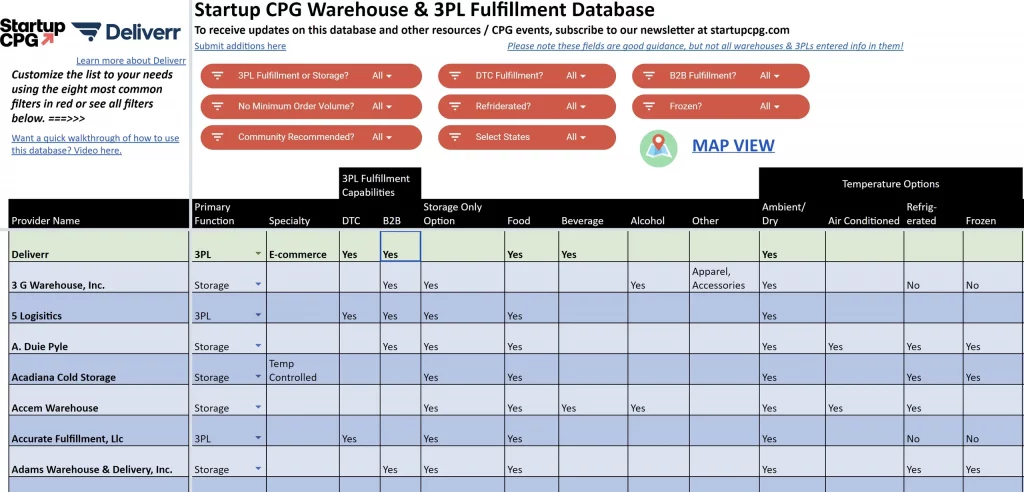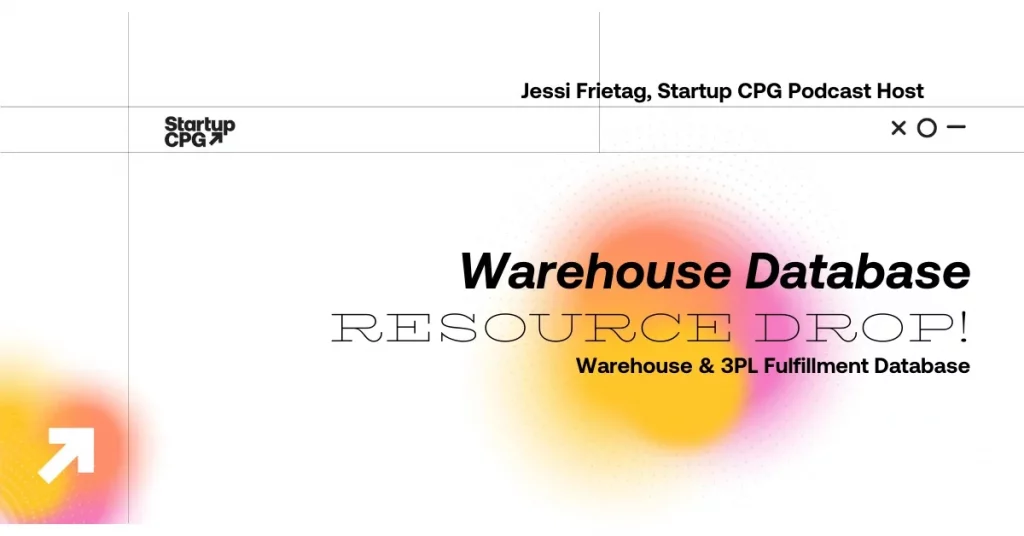Startup CPG Launches
Warehouse & 3PL Fulfillment Database
Jessi Freitag is the Startup CPG Podcast host and builds products for Startup CPG that help emerging brands grow faster. This resource is proudly sponsored by Deliverr, a national fast and affordable fulfillment provider.
Startup CPG has released the first Warehouse & 3PL Fulfillment Database connecting warehousing and 3PL fulfillment providers with emerging food & beverage brands who need storage, DTC fulfillment, and/or B2B fulfillment services. Links to access the database are at the bottom of the article.
Warehousing & 3PL Fulfillment in CPG
Some of the most common requests within the 7,000 person Startup CPG community are related to brands looking for new fulfillment partners to take on their ecommerce and wholesale orders or brands needing short and long term storage of product, raw materials, or packaging.
With 96% of warehousing space in the US occupied and available space declining steadily over the past few years (according to commercial real estate services company JLL), it is extremely challenging for small brands to get the attention of 3PL and warehousing providers. Emerging brands are looking for vetted options all in one place.
Startup CPG has curated the first list of warehouse and 3PL fulfillment providers just for CPG companies (created and crowdsourced by Startup CPG members). Startup CPG previously released a list of 3PLs focused on DTC fulfillment in August 2020, and this new list replaces that resource with expanded options for B2B fulfillment and storage-only options.
In this article, we’ll cover:
- How to find short and long term storage options
- How to navigate fulfillment service options and filterable fields in the database
- How to choose the right fulfillment partner for your CPG brand
- How to access the new database
Ryan Gallagher, Director Of Operations at Taika, shared about value of having all the fulfillment partner options in one place:
“Finding the right 3PL was a lengthy process with so many considerations – minimum order volume, geographic location, ability to kit sampler packs, multi sku pallets, etc. Having a filterable database of potential partners would take a lot of the guesswork out, and save so much frustration. I’m really looking forward to using Startup CPG’s resources in the future!”
Finding Storage Options
Sometimes you just need to store a pallet or a few pallets for a couple weeks or months. As we note below, sometimes 3PL fulfillment partners offer short and long term storage options (which are noted in the database), but often these options come at a higher price. In the database, “primary function” of a partner is noted, so that you can search for partners that focus only on storage and may have lower rates since they don’t offer high-touch services.
Warehousing availability often shifts rapidly and varies widely by location. If you don’t find an option nearby your area with availability in the database, other options to utilize include:
- Warehouse Exchange: Search for available warehouse space by facility capabilities like temperature control options, and Warehouse Exchange handles the storage agreement
- OLIMP – Create a free account to search their 1,700+ warehouses for short term warehouse space by zip code, # of days needed to store, # of pallet skids, cross dock and pallet rework capabilities, FDA compliance, and temperature control options.
- Warehowz: Create a free account to search their 1,200+ active listings for available warehouse space
- LoopNet: Search for available commercial space near you, including sublease options
- Digsy: Search by lease terms and square footage needs for commercial space
Fulfillment Service Options
Looking for a new company to fill your Shopify orders? Or ship orders to KeHE? Need variety packs created or sell sheets added to some shipments? Some of the most common fulfillment service options are listed below and are noted in the database based on available information for each provider.
- DTC/D2C (Direct to consumer): manages shipping directly to end consumers, often ecommerce/brand website orders
- B2B (Business to business): manages shipping to distributors, retailers, corporations, etc., often pallet volumes
- Storage: Fulfillment providers have to store enough active inventory to fulfill shipments, but some can also offer short or long term storage of product not part of their fulfillment process (example: storing an extra pallet or raw materials or packaging short term)
- Food-Grade: Not all warehouses are suitable for storing, packing, and shipping food. Food-grade warehouses have specific sanitation, security, and safety requirements
- Beverage or Alcohol: Not all fulfillment providers have the capabilities to handle liquids/beverages. Storing/shipping alcohol also has additional regulations
- Temperature Options: Generally there are four types of warehouse temperature options:
- Dry/Ambient: No temperature control – usually used for dry products with no specific temperature requirements for preservation as temperatures may vary widely
- Air Conditioned: Usually between 56°F and 75°F – good for products like chocolate and candy
- Refrigerated: Between 33°F and 55°F – good for produce, cold beverages, etc.
- Frozen: At or below 32°F – good for products that must remain frozen to retain integrity
- Most warehousing space is “dry” and temperature-controlled options are more limited.
- Pick & Pack: ability to retrieve specific items to fulfill an order and create a custom shipment (example: picking one innercase of one flavor of food product from one pallet and one innercase of another flavor of the product from another pallet to build an order versus only shipping one type of order)
- Repack: ability to reconfigure items into different packaging options (example: manufacturer sends product in bulk without an innercase and fulfillment partner breaks into innercases)
- Kitting: ability to prep frequent orders into “kits” ready for shipment. Whereas pick and pack refers to picking individual orders, kitting involves forecasting a number of certain types of orders and prepping in advance (example: picking three individual bars from four different innercases with separate flavors to create one new multi-pack innercase with twelve bars but four flavors for a common online “variety pack”)
- Certifications: Some common options include USDA Organic, Food Safety (SQF, AIB Superior, BRC), Quality Management (ISO 9001), Woman-owned, and Climate Neutral
Delivery Window: Expected time from fulfillment center to end recipient. Most providers have a 2-3 day window, with some offering same day options - Minimum Order Volume: Some fulfillment providers require a specific number of orders per month and/or amount of spend per month. Providers with no minimums are noted in the database
- Ecommerce Integrations: ability to integrate with common ecommerce platforms such as Shopify, Magento, Wix, Squarespace, WooCommerce, BigCommerce, etc. – some providers specialize in more robust integrations for specific platforms and others have custom API capabilities where they can integrate with most any platform on some level
- Retailer Integrations: ability to integrate with online and/or brick and mortar retailers such as Amazon, Walmart, Etsy, eBay, Costco, Target, distributors such as KeHE or UNFI, or EDI providers such as SPS
Harish Abbott, CEO of Deliverr, shared about what the right 3PL partner can achieve:
“The right 3PL makes life easier so you can invest your time and money in your customers, not worrying about your logistics. The right 3PL should provide a one-stop-shop from ship to doorstep; give you maximum visibility and the ability to take intelligent action with your inventory and channels; scale to any sales channel or marketplace; and put your inventory where it needs to be, to maximize fulfillment speeds, decrease storage costs, and decrease your carbon footprint.”
Choosing a Fulfillment Partner
So how do you choose a fulfillment partner or partners from all of these options? Here are some of the top things to consider:
- What is the fulfillment partner’s communication style and does it fit with your business? Do they use email, phone, and/or Slack? Will you have a dedicated representative? This isn’t any vendor; this is the vendor responsible to get your product to consumers and retailers on time and inline with your brand’s core values, so you have to make sure they feel like a natural extension of your team.
- What is the expertise of this fulfillment center? Did they ship ice cream for one brand one time or do they specialize in ice cream? Do they know your product type and how to most efficiently ship your product? Can they advise you on topics like reducing your dimensional weight, especially as you scale? (On that note, Simpl Fulfillment has a great overview and calculator for dimensional weight.) Do they have experience with the right retailers and that retailer’s specific requirements? Can they fulfill Amazon FBA (Fulfilled by Amazon) and/or FBM (Fulfilled by Merchant)?
- What is their availability? Do they ship on weekends? What is their average order turnaround time? Do they allow local pickup if you need to swing by and grab a case of something (not all do!)?
- Where are they located? Are they in a metropolitan area or out of the city and how will that affect your freight costs? Do you need a fulfillment center near your co-manufacturer? Do they have multiple locations if you need an East and West Coast warehouse or storage across the country?
- Do they offer the customizations you need? Can they add sell-sheets or tissue paper or prep unique press/influencer kits?
- Can they process returns, including Amazon returns?
- How does their pricing work? Is it per unit, per hour, per square foot of storage, all of the above? Are there charges for receiving, pallet fees, etc.? You’ll notice pricing is lower on this list; pricing isn’t always the main consideration when comparing partners. Overall fit with your business and partnership quality also have value to be considered. OTW Shipping has a great free calculator on their website for comparing multiple fulfillment partners with different pricing structures.
These are just questions to start the conversation. Red Stag Fulfillment has a downloadable free comprehensive questionnaire with questions to ask potential 3PL partners.
Sam Tichnor, Founder & CEO of FFUPs, shares his tip for comparing fulfillment partners:
“Many 3PLs will quote certain line items differently, so going in eyes-wide-open with an organized spreadsheet outlining exactly what the costs (and other determining factors like location) will be for your business can help you decide on a 3PL that is right for you.”

How do I access the full list of hundreds of Warehouses and 3PL Fulfillment Providers?
The list is available for free, along with Startup CPG’s other resource lists:






All Comments